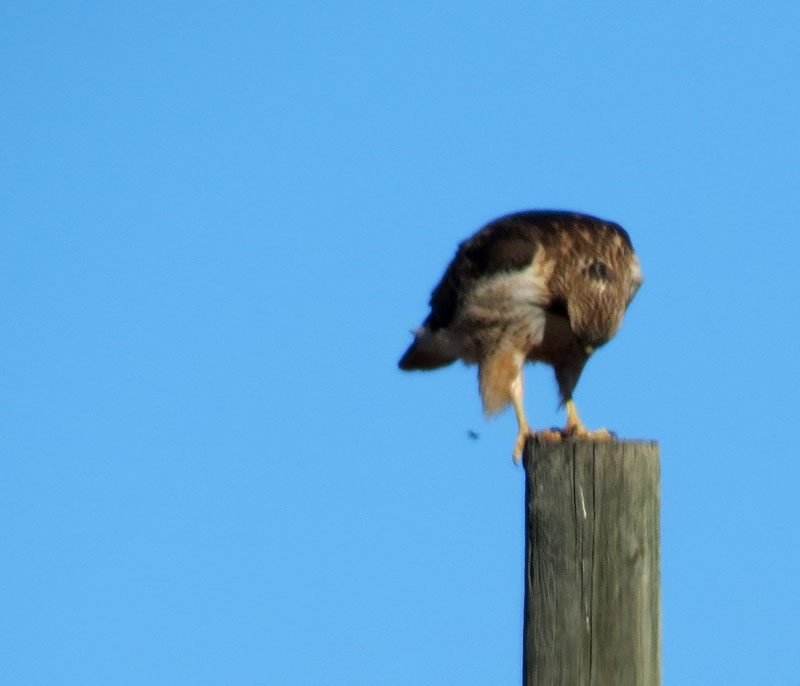“Look,” Barb pointed as I eased along the road that was our first stop to count bluebird species as part of the National Audubon’s Climate Watch initiative. A Red-tailed Hawk was perched behind some bushes on top of roof of a shed hoping for breakfast.

Red-tailed Hawk
“There won’t be many birds at this stop,” she continued sadly.
“It is probably waiting for a squirrel.” I commented.
Just beyond its hiding place, two Mountain Bluebirds and a Western Bluebird perched on a wire.
As we got out of the car to start our five-minute point count,

the hawk flew further down the road and landed on top of a pole and we began to see Mountain Bluebirds emerge from the grasses.
One perched up top of a pole for a long time.

Mountain Bluebird (female)
When the alarm on my phone signaled the end of the five minutes, we had counted 19 Mountain Bluebirds and one Western Bluebird.
Just as we were about to get back in the car, the Red-tailed Hawk swooped down and grabbed one of the Mountain Bluebirds and flew up to his perch to polish it off.

Red-tailed Hawk with bluebird breakfast
We were one of sixteen teams from Central New Mexico Audubon counting bluebirds between January 15 and 30. Counts occurred at spots along the Rio Grande from the Valle de Oro NWR to Bernalillo, in the Sandia foothills, in Cedar Crest, Sandia Park, La Madera Overlook, in the East Mountains and almost to Tajique in the Manzano Mountains.
I counted along this route last January and again in early June.
In New Mexico, Western Bluebirds nest in tree cavities from this elevation up to 10,000 feet. By the end of September, they have left the higher elevations and migrated to the East Mountains, foothills

Western Bluebirds in Elena Gallegos Open Space
and along the Rio Grande. The Climate Change report, rolled out in 2014 using scientific modeling, has predicted that only 37% of the summer habitat will be stable by 2080.
The prevalence of Mountain Bluebirds in central New Mexico varies from year to year. This year they have been more prevalent in the valley areas and we saw more of them in this area on the Christmas Bird Count than we did the prior year. Mountain Bluebirds in the Sandia and Manzano Mountains nest in tree cavities on hillsides adjacent to more open areas where they can hunt for insects. After nesting, they move to the open areas and during the winter often gather in larger groups. NAS predicts a 73% decrease in summer range in 2080 from 2000.
At the next two stops, we saw lots of American Robins and a few Western Bluebirds.

Western Bluebird
At our fourth stop we once again encountered large groups of Mountain Bluebirds.
“Look at them on that tree,” Barb motioned. “They are fluttering like butterflies.”

Mountain Bluebirds hovering in juniper bush
Mountain Bluebirds often hover as they search for food. While this is often an aerial display, like this picture I took of one foraging in the Socorro area a few years ago,

Mountain Bluebird hovering over field
it can also be the ‘butterfly-like’ behavior we were witnessing.
At this stop we were also treated to the antics of a wintering flock of 8 Woodhouse’s Scrub-Jays,

Woodhouse’s Scrub-jay
identified by the New Mexico Avian Partners as a species of high risk, as they interacted with each other.
By time we had completed our 12 point counts, we had tallied 90 Mountain Bluebirds and 52 Western Bluebirds. Not only was it an enjoyable morning, but we had the satisfaction of knowing we had contributed as citizen scientists by documenting the impact of climate change on bluebirds.

I couldn’t think of a more enjoyable way to spend a day. Bluebirds just make you smile.
I see many bluebirds in the Albuquerque bosque, but almost exclusively Eastern Bluebirds. Are Eastern included in the surveys?
Yes, but not often in the area we were surveying. We need to enlist you to survey ‘your’ patch of the bosque in June!
Glad to do it!
One of the most memorable birding experiences I had was a few years ago when I visited a friend’s ranch out near Fence Lake, New Mexico one November day. There were hundreds of mountain bluebirds all around us. It was magical.
The pictures and your descriptions are gratefully appreciated.
Jan Micali
Pingback: Wildlife Highlights of 2017 | It's a bird thing...